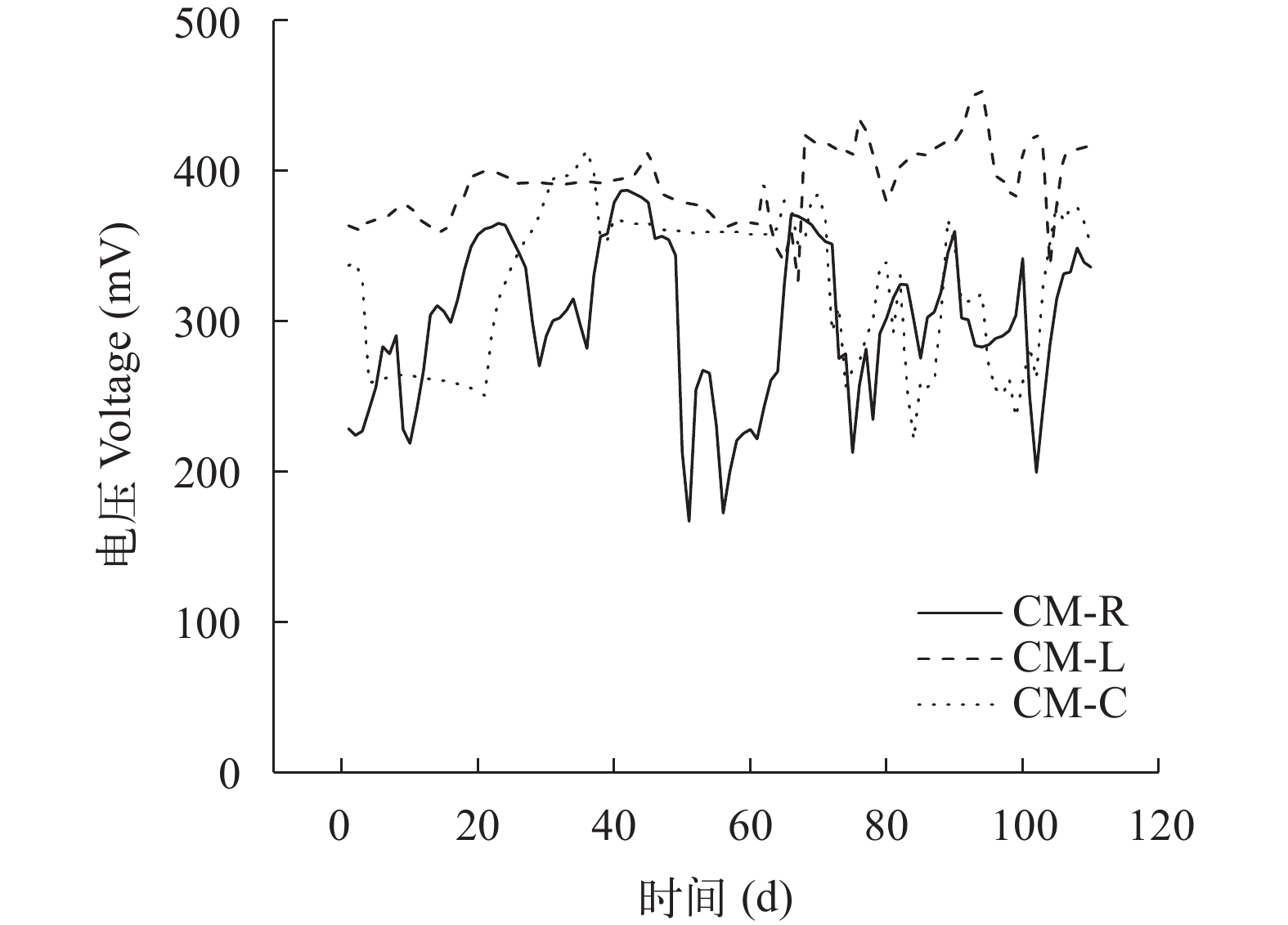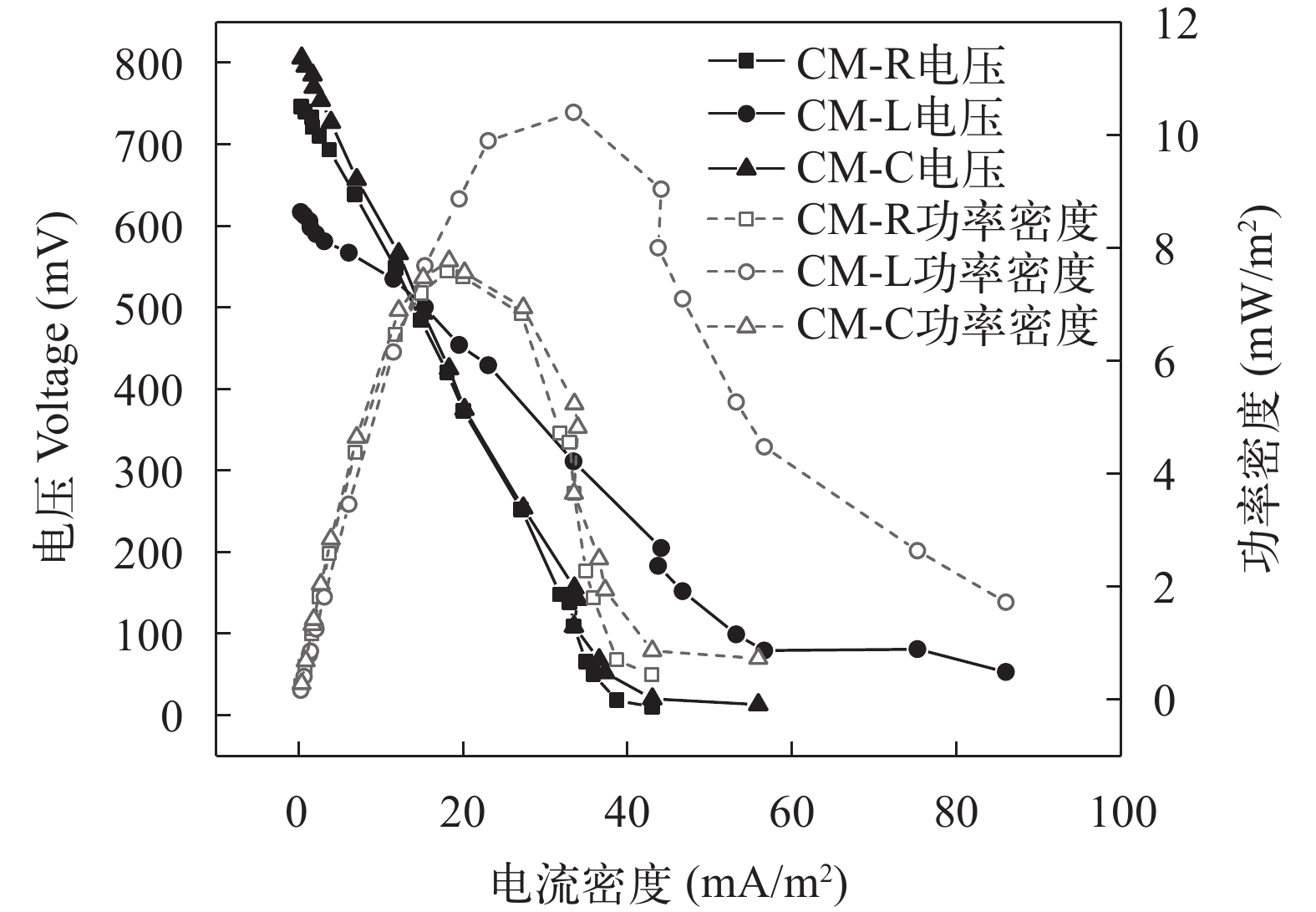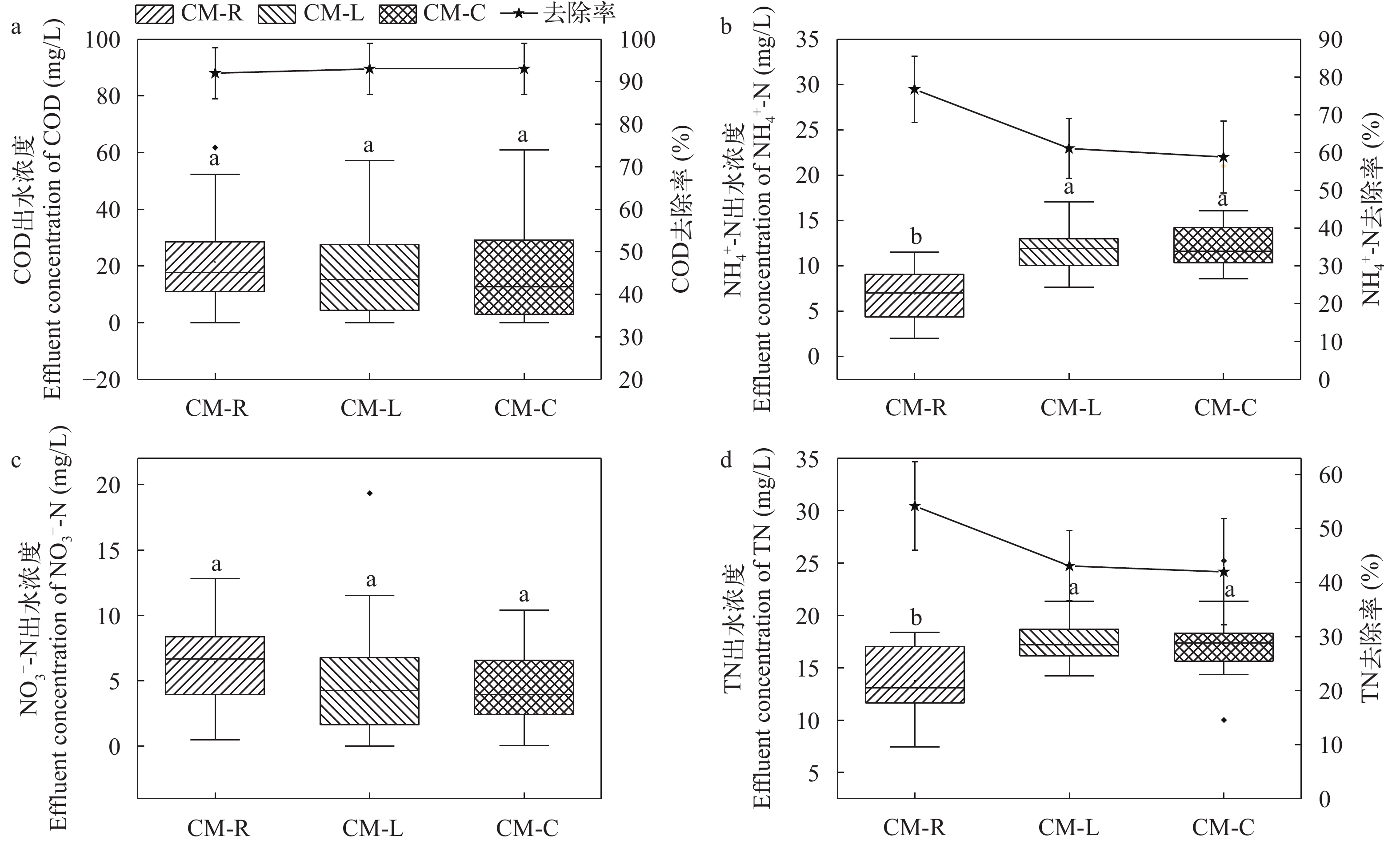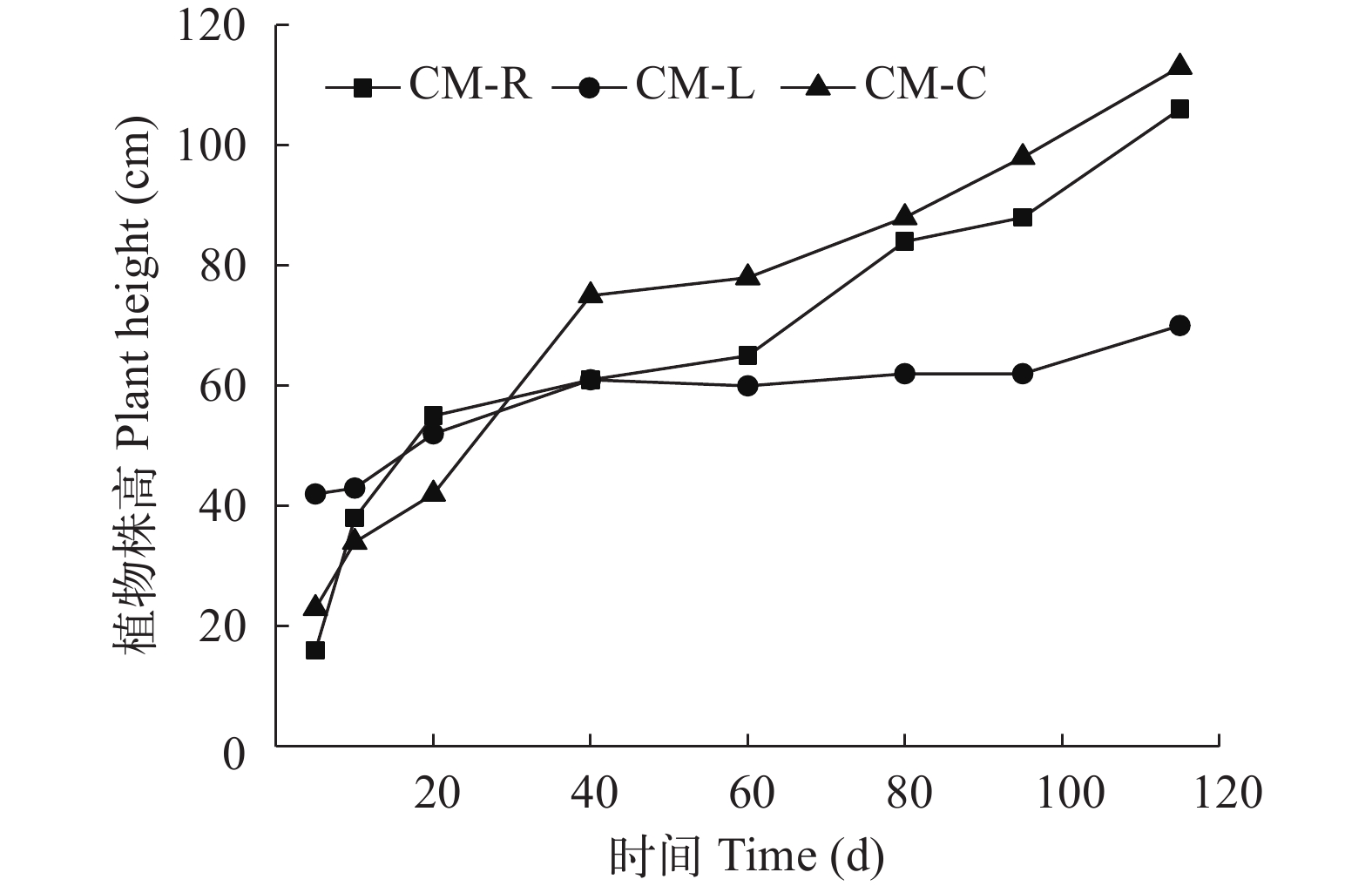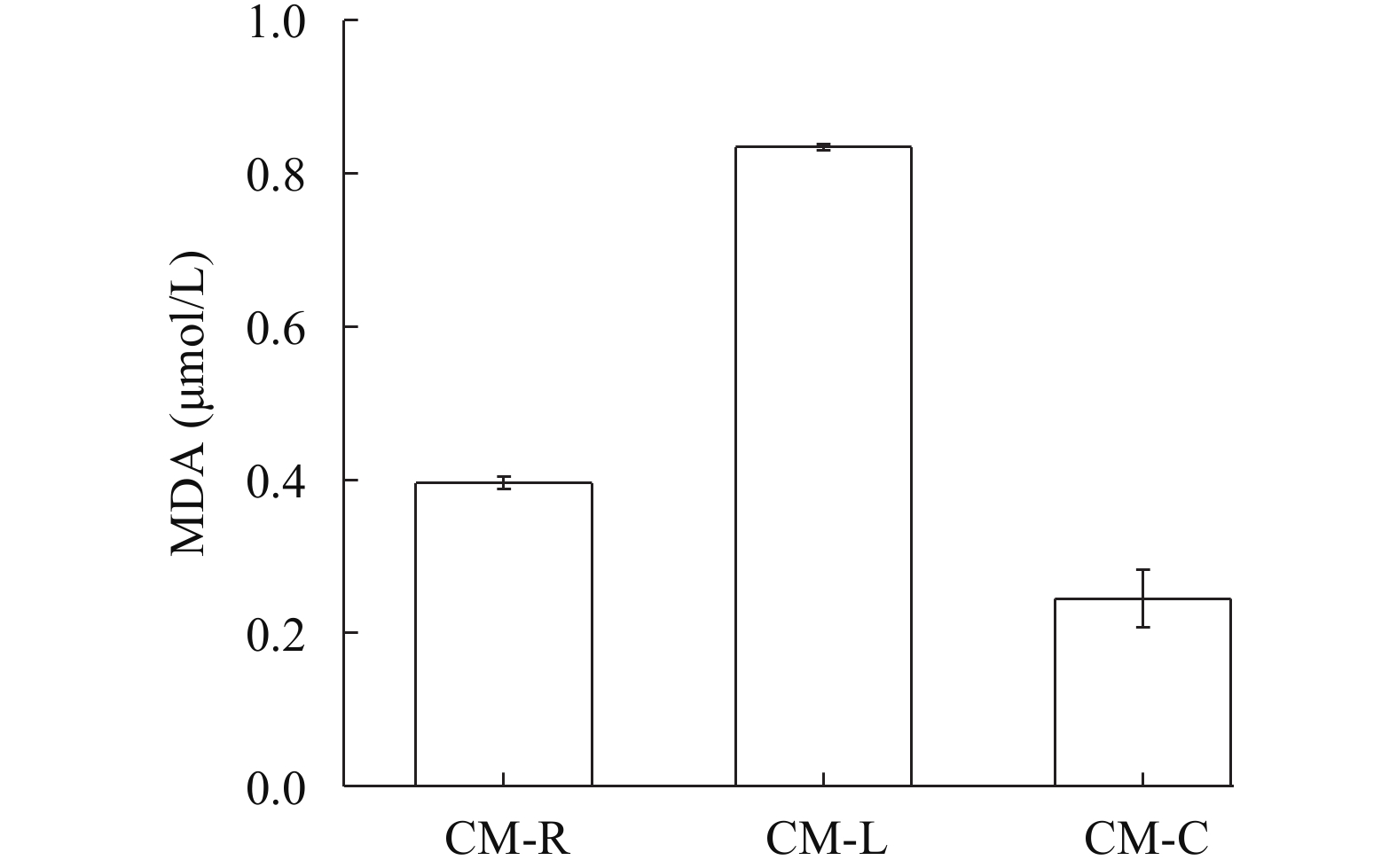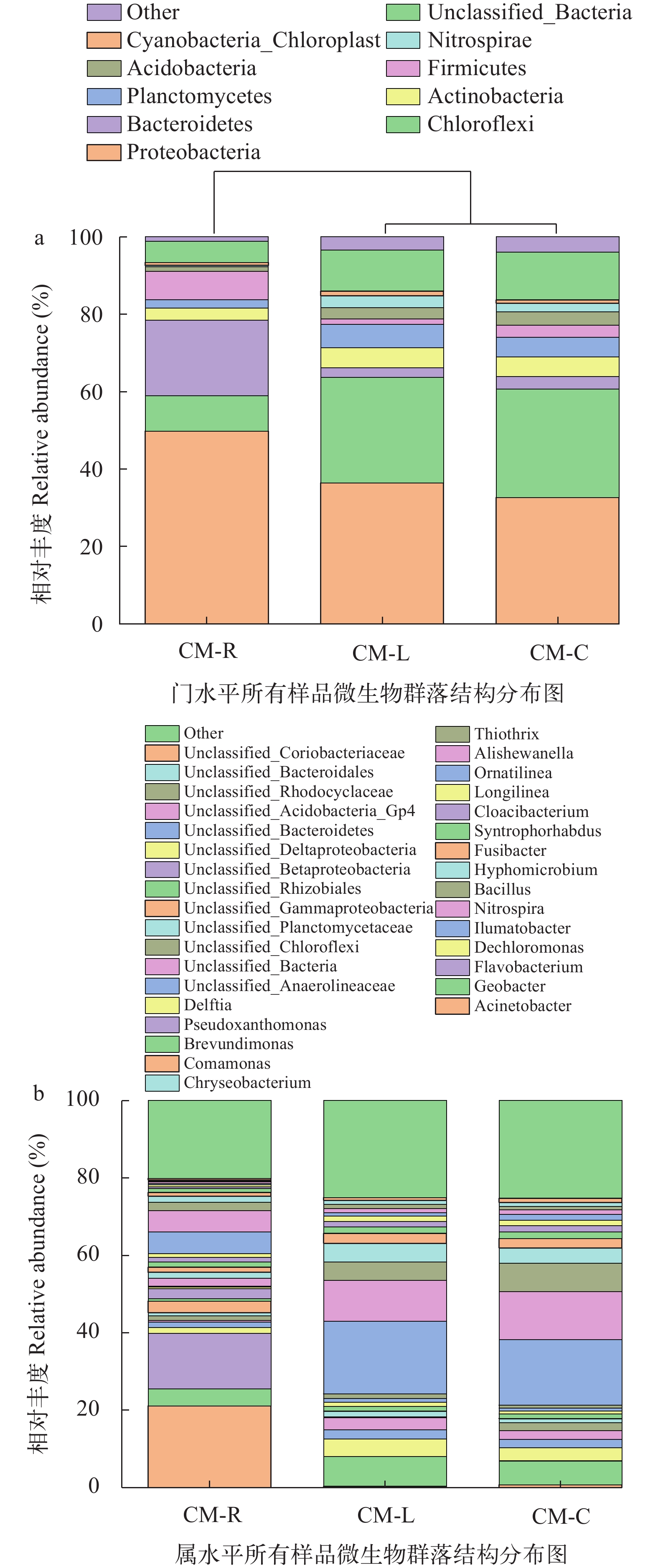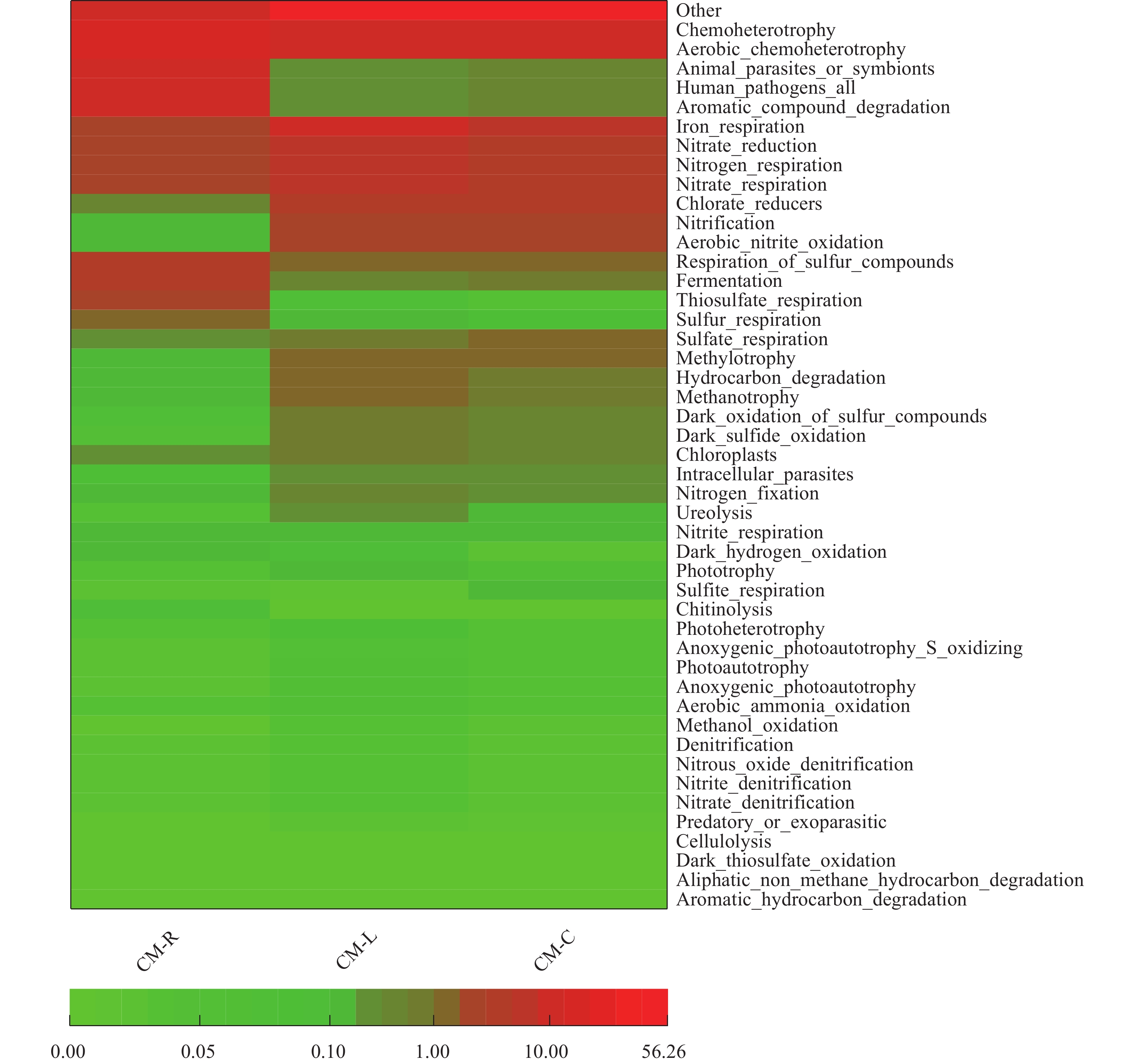THREE EMERGENT AQUATIC PLANTS ON NITROGEN REMOVAL AND ELECTRICITY GENERATION PERFORMANCE OF CW-MFC COUPLING SYSTEM
-
摘要: 为探究不同植物类型对人工湿地微生物燃料电池系统(CW-MFC)耦合系统脱氮和产电性能的影响及机制, 分别以芦苇(reed)、千屈菜(Lythrum salicaria)和美人蕉(Canna indica)构建3组CW-MFC小试系统, 依次标记为CM-R、CM-L及CM-C。结果显示: (1) CW-MFC耦合系统的输出电压和功率密度呈现CM-L>CM-C>CM-R; (2) CM-R耦合系统的
${\rm{NH}}^+_4 $ -N和TN去除率[(76.8±9.9)%; (54.2±8.2)%]显著高于CM-L[(61.2±8.0)%; (43.1±6.5)%]高于CM-C[(58.9±9.5)%; (42.0±9.8)%], P<0.01; (3) 植物生长速率整体表现为CM-R>CM-C>CM-L, 并且千屈菜(CM-L)的叶片中MDA含量最高, 代表其受损害程度可能较高; (4) 地杆菌属(Geobacter)作为典型的产电菌属, 在3个耦合系统中均具有较高丰度(4.45%—7.64%), 并且其相对丰度大小与输出电压和功率密度大小变化趋势一致, 此外, CM-R中不动杆菌属(Acinetobacter)和黄杆菌属(Flavobacterium)的相对丰度分别为21.10%和14.37%, 显著高于其他两个系统(CM-L: 0.33%和0.10%; CM-C: 0.75%和0.07%), 是CM-R中主要的脱氮菌属; (5) 结合FAPROTAX 预测结果可知, 共检测出包括化能异养、好氧化能异养、铁呼吸、硝酸盐还原和氮呼吸等在内的47组功能群组, 同时结果还表明CM-R耦合系统的功能群组与其他两个系统差异较大, 其中化能异氧和好氧化能异养功能群组在CM-R中占比较高。该结果有助于加强植物对人工湿地微生物燃料电池耦合系统产电和脱氮性能影响的认识。Abstract: To explore the effects and mechanisms of different wetland plants on nitrogen removal and electricity generation performance of CW-MFC coupling system, three groups of CW-MFC pilot systems were constructed with reed, Lythrum salicaria, and Canna indica, which were recorded as CM-R, CM-L, and CM-C, respectively. The results revealed that: 1) the output voltage and power density of CW-MFC coupling system were CM-L>CM-C>CM-R; 2) the NH4+-N and TN removal rates of CM-R coupling system [(76.8±9.9)%; (54.2±8.2)%] were higher than that of CM-L system [(61.2±8.0)%; (43.1±6.5)%], which were higher than that of CM-C system [(58.9±9.5)%; (42.0±9.8)%], P<0.01; 3) the overall growth rate of plants was CM-R> CM-C>CM-L, and the MDA content was the highest in the leaves of Lythrum salicaria (CM-L), indicating that the degree of its damage may be higher; 4) Geobacter, as a typical electrogenesis genus, had a high abundance (4.45% to 7.64%) in all three coupling systems, and its abundance was consistent with the change trend of output voltage and power density, whereas the relative abundance of Acinetobacter and Flavobacterium in CM-R was 21.10% and 14.37%, significantly higher than that of the other two systems (CM-L: 0.33% and 0.10%; CM-C: 0.75% and 0.07%), which was the most dominant genus of denitrification bacteria in CM-R; 5) combined with the FACOPTAX predictions, a total of 47 functional groups including chemoheterotrophy, aerobic chemoheterotrophy, iron respiration, nitrate reduction and nitrogen respiration were detected, and the results also showed that the functional groups of the CM-R were quite different from the other two systems, among which the functional groups of chemoheterotrophy and aerobic chemoheterotrophy accounted for a relatively high proportion in CM-R. The results will help to strengthen plant understanding of the effects of electrogenesis and denitrification performance on the CW-MFC coupling system.-
Keywords:
- Plant /
- Constructed wetland /
- Microbial fuel cell /
- Nitrogen removal /
- Electricity generation
-
人工湿地微生物燃料电池(Constructed wetland-microbial fuel cell, CW-MFC)耦合系统可以由预埋于湿地内不同梯度氧化还原层中的电极搭建而成, 能够显著提高污染物的去除效果, 同时实现化学能向电能的转换。目前, 该耦合系统已经被成功地应用于去除多种污(废)水中的污染物质, 如偶氮染料[1]、重金属[2]、氨氮[3, 4]及抗生素[5]等。对CW-MFC的脱氮研究主要集中于优化运行参数以提高系统产电及(或)处理性能方面, 例如改善电极材料[6]、优化运行条件[7]、构造多个生物阴极[8]、连续曝气[9]及改变进水流向[10]等。
植物作为人工湿地的重要组成部分, 在CW-MFC耦合系统中具有特殊作用, 主要表现为3个方面: (1)当阳极位于植物根系区域时, 植物根系分泌的低分子有机物可被CW-MFC阳极产电菌作为燃料驱动生物产电过程[11, 12]; (2)当阴极位于植物根系区域时, 根系泌氧作用可增加阴极电子受体量(O2), 从而提高其产电性能[13]; (3)湿地植物根系还会因自身的代谢作用而影响根系周围微生物的种群结构从而间接影响耦合系统的脱氮性能[3]。现有研究已证实, 与未种植植物的CW-MFC相比, 种植植物的CW-MFC有更高的产电性能及污染物去除能力(如有机物、N和P等)[14], 并且不同植物种类CW-MFC在产电及污染物去除能力方面存在显著差异[15]。尽管有学者在进行CW-MFC研究时对部分植物类型进行了考察与比较, 但是对于不同植物类型CW-MFC产电性能与脱氮效率之间的内在关系仍没有明确认识。
为探究植物对CW-MFC耦合系统脱氮及产电性能的影响, 本文选取3种常见的挺水植物(芦苇、千屈菜和美人蕉)构建微宇宙试验, 通过考察CW-MFC耦合系统的输出电压、功率密度及进、出水中氮素浓度变化及植物生理响应[植物株高及叶片丙二醛(MDA)含量], 系统解析植物类型对CW-MFC耦合系统脱氮及产电效能的影响。同时, 运用高通量测序方法分析植物类型对CW-MFC系统阳极微生物群落结构的影响。
1. 材料与方法
1.1 试验装置的构建
如图 1所示, CW-MFC反应器由上下两个连通的有机玻璃圆柱堆叠而成, 下部圆柱体直径12 cm、高57 cm, 上部圆柱体直径20 cm、高3 cm。反应器从下到上依次为底部砾石层(粒径1—2 cm, 厚度25 cm)、阳极层(厚度15 cm)、砾石隔离层(粒径1—2 cm, 厚度17 cm)以及阴极层(厚度5 mm)。阳极层填充有椰壳活性炭(粒径为2—4 mm), 同时将宽为10 cm、长为15 cm的石墨碳毡卷曲后置于椰壳活性炭中以收集电子。阴极是直径为18 cm的石墨碳毡直接放置于上部圆柱体中。阳极和阴极相距17 cm, 通过钛丝和500 Ω的外部电阻连接。从南昌某污水处理厂取得的活性污泥经过曝气后接种到反应器中。合成污水从底部以1.8 mL/min的速度从反应器底部连续泵入, 相当于24h的水力停留时间。实验装置放置在阳光充足、通风良好的区域, 为了防止藻类生长, 在有机玻璃反应器周围包裹了一层遮光膜。
分别以芦苇(Reed)、千屈菜(Lythrum salicaria)和美人蕉(Canna indica)构建3组CW-MFC小试系统, 依次记为CM-R、CM-L及CM-C。实验所用植物取自东华理工大学校园内, 芦苇、千屈菜和美人蕉初始株高分别为16、42和23 cm。以植物裸露部位(即阴极表面)到植物顶端叶尖的长度作为植物株高。
为消除植物对实验中的干扰, 在实验开始前, 本实验所用植物需要先用清水去除植物根和茎表面的土壤残留物, 以及放置桶中培养1周后再移植到装置中。
1.2 实验用水配制
This page contains the following errors:
error on line 1 at column 1: Start tag expected, '<' not foundBelow is a rendering of the page up to the first error.
1.3 分析方法
This page contains the following errors:
error on line 1 at column 291: Extra content at the end of the documentBelow is a rendering of the page up to the first error.
${\rm{NH}}^+_4 $
输出电压由无纸化电压记录仪每隔15min记录、存储。根据欧姆定律和工作电压可计算得到电流值。功率密度是电池单位面积或单位体积上产生的电功率, 通常用阳极表面积标准化的方式来计算:
$ P_{\text{ρ}}\text= \frac{I U}{S} \text= \frac{U^{2}}{R_{\operatorname{ex}} \times S} $


式中, Pρ为功率密度, mW/m2; I为电流, mA; U为输出电压, mV; S为阳极区域有效横截面面积, m2; Rex为外加电阻阻值, Ω。
采用硫代巴比妥酸法(TBA)测定植物叶片中丙二醛含量, 其原理为: 在酸性条件下加热与叶片组织中的丙二醛产生显色反应, 并在532、600和450 nm波长处测定吸光度值, 即可计算出丙二醛含量。
实验结束后, 从每个反应器阳极层中取出一定量活性炭用以提取微生物, 并进行16S RNA微生物高通量测序。所有样品的提取、扩增和测序服务均由上海生工生物技术有限公司(中国上海)提供, 具体步骤参见文献[16]。
2. 结果与讨论
2.1 产电性能比较分析
产电特性 如图 2所示, CM-R、CM-L和CM-C的平均电压分别为(300±53)、(392±26)和(324±52) mV, 说明种植千屈菜最有利于CW-MFC系统产电。本研究中的阳极均置于植物根系附近, 因此植物根系分泌的低分子有机物可为阳极提供氧化介质, 同时能够增加阳极区中微生物群落丰富度和多样性, 有利于提高CW-MFC产电性能。Yang等[17]的研究表明, 与未种植植物的CW-MFC相比, 种植植物可提升CW-MFC耦合系统68%—97%的输出电压, 且不同植物CW-MFC组的输出电压大小与各组植物生长顺序相同, 即鸢尾>芦苇>风信子。本研究中CM-L耦合系统产电性能最好, 可能归结于其根系能分泌更多的有机碳化合物[18]。根系分泌物是植物根系与其周边土壤或基质进行物质交换和信息传递的重要载体物质, 同时也是影响植物不同根际微生态特征的关键因素。有许多研究表明, 植物类型是根系分泌物组分和含量的重要影响因素[19, 20], 因此不同植物对CW-MFC耦合系统产电和污染物去除的促进作用不尽相同。
极化曲线及功率密度曲线 图 3是不同植物CW-MFC耦合系统的功率密度曲线和极化曲线, 可用以分析不同系统的产电特性。CM-R耦合系统的开路电压为765 mV, 最大功率密度为7.59 mW/m2, 内阻为407 Ω; CM-L耦合系统的开路电压为617 mV, 最大功率密度为10.40 mW/m2, 内阻为170 Ω; CM-C耦合系统的开路电压为806 mV, 最大功率密度为7.77 mW/m2, 内阻为379 Ω。最大功率密度整体表现为CM-L>CM-C>CM-R, 与输出电压大小变化趋势一致。由此可知, 可通过筛选适宜的湿地植物类型来降低CW-MFC耦合系统内阻, 从而提高系统产电性能。
2.2 污染物去除效果
This page contains the following errors:
error on line 1 at column 1: Start tag expected, '<' not foundBelow is a rendering of the page up to the first error.
This page contains the following errors:
error on line 1 at column 1: Start tag expected, '<' not foundBelow is a rendering of the page up to the first error.
This page contains the following errors:
error on line 1 at column 1: Start tag expected, '<' not foundBelow is a rendering of the page up to the first error.
2.3 植物生理响应
植物生长速率 植物的生长状况可间接反映植物对污水的去除效果, 良好的生长状态有利于提高植物对污水中污染物的去除率。植物发达的根系可以为微生物提供附着点, 营造较好的生存环境, 从而有利于污染物的去除。本研究中的3种植物均为须根型, 根系发达, 在实验结束时可以明显观察到植物根的数量和最大根长均有明显增长, 尤其以芦苇的变化最为明显。由图 5可知, 千屈菜的生长速率较慢, 而芦苇和美人蕉的生长速率较为接近。在装置运行到第110天时, 芦苇、千屈菜和美人蕉的株高分别为106、70和113 cm, 与初始株高相比分别增长了90、28和90 cm。从生长状态来看, 千屈菜生长状态较差, 最先出现叶片发黄和叶片掉落现象, 其次是美人蕉, 而芦苇生长状况良好, 没有出现明显的衰落。
植物叶片MDA含量 MDA作为一种脂质过氧化产物可以评估逆境环境中植物的损伤程度及植物的抗逆性, 且含量越高, 损伤程度越大, 对植物的生长阻碍作用越大。由图 6可知, CM-L耦合系统千屈菜叶片中MDA含量最高(0.834±0.004) μmol/L, CM-C的美人蕉叶片中MDA含量最低(0.245±0.038) μmol/L, CM-R的芦苇叶片中MDA含量居中, 为(0.396±0.008) μmol/L。因此, 结合植物生长情况和叶片MDA含量, 可以判断千屈菜在产电环境下受损害程度可能较高, 而芦苇和美人蕉则能较好地适应产电环境。
2.4 阳极微生物群落结构分析
Alpha多样性分析 本文采用16S RNA微生物高通量测序, 分析了各植物CW-MFC耦合系统根系周围阳极活性炭的微生物群落结构变化。通过Chao 1丰富度指数、ACE丰富度指数、Shannon多样性指数和覆盖度指数来评估每个系统阳极区基质中的微生物多样性和群落丰富度。如表 1所示, Chao1指数与ACE指数可表征微生物丰富度, 各样本Chao1指数介于1699.29—1902.40, ACE指数介于1706.81—1889.82, 两者都呈现CM-C>CM-L>CM-R的特征。Shannon指数可反映系统中微生物群落结构的多样性。各样品中Shannon指数在4.50—6.00, 且表现为CM-C>CM-L>CM-R。以上结果表明: 种植美人蕉的CW-MFC耦合系统阳极微生物丰富度与多样性均最高, 千屈菜次之, 芦苇最低。
表 1 不同植物 CW-MFC系统微生物群落多样性分析Table 1. Microbial community diversity analysis of CW-MFC systems with different plants样品 Chao1 ACE Shannon Coverage (%) CM-R 1699.29 1706.81 4.50 98.84 CM-L 1828.03 1795.80 5.88 98.69 CM-C 1902.40 1889.82 6.00 99.10 门和属水平细菌组成分析 图 7a以门作为分类单元, 对CW-MFC系统中不同湿地植物情况下细菌群落进行了分析。由图可知, 各样品的微生物组成在门水平上相似, 主要有变形菌门(Proteobacteria)、绿弯菌门(Chloroflexi)、拟杆菌门(Bacteroidetes)、放线菌门(Actinobacteria)、浮霉菌门(Planctomycetes)和厚壁菌门(Frimicute)等是3个CW-MFC耦合系统阳极的主要优势菌门。在CM-R中, 变形菌门, 绿弯菌门及拟杆菌门是前三位优势菌门, 其中变形菌门相对丰度最高, 达到49.9%, 绿弯菌门与拟杆菌门相对丰度分别达到9.9%及19.9%, 三种菌门之和达到78.8%。然而, 在CM-L和CM-C中, 变形菌门、绿弯菌门和浮霉菌门为前三位优势菌门, 最具优势菌门又以变形菌门为主, 分别占细菌总数的 36.35%和32.61%。在CM-L中, 绿弯菌门和浮霉菌门分别占到细菌总数的27.35%和6.08%, 两者与变形菌门之和占到细菌总数的69.78%; 在CM-C中, 绿弯菌门和浮霉菌门分别占到细菌总数的28.11%和5.08%, 两者与变形菌门之和占到细菌总数的65.8%。由此可见, 种植芦苇的CW-MFC系统的变形菌门和拟杆菌门相对丰度要高于其他两种植物体系, 且变形菌门呈现CM-R>CM-L>CM-C, 拟杆菌门呈现CM-R>CM-C>CM-L。已有研究表明[28, 29], 变形菌门对污染物的去除与降解起着至关重要的作用, 多数起脱氮作用的微生物都被归属于变形菌门; 拟杆菌门微生物为化能异养细菌, 能够代谢各种营养物质, 主要起COD降解功能, 同时也具有脱氮除磷的作用。因此, 种植芦苇的CW-MFC耦合系统中高丰度变形菌门与拟杆菌门的存在可能与良好的脱氮效率有关。
属水平上的微生物群落组成及相对丰度如图 7b所示, CM-C和CM-L在属水平微生物构成较相似, 而CM-R差异显著。CM-R的前三个优势菌属为不动杆菌属(Acinetobacter)、黄杆菌属(Flavobacterium)和未分类的厌氧绳菌科 (unclassified Anaerolineaceae), 相对丰度分别为21.10%、14.37%和5.58%; CM-L和CM-C的前三优势菌属均为未分类的厌氧绳菌科、地杆菌属(Geobacter)和未分类的绿弯菌门(unclassified Chloroflexi), CM-L中相对丰度分别为18.73%、7.64%和4.80%, 而CM-C中相对丰度分别为16.94%、6.09%和7.33%。上述结果表明, 芦苇根系促进了不动杆菌属及黄杆菌属的富集生长。一些不动杆菌属与黄杆菌属的细菌被证实具有异养硝化-好氧反硝化功能[30, 31], 未分类厌氧绳菌科是厌氧菌的一个与有机碳降解有关的类群。不动杆菌属与黄杆菌属在CM-R中的相对丰度高于另外2组系统, 这表明芦苇根系强大泌氧能力营造的好氧环境可能促进了CM-R阳极区域异养硝化-好氧反硝化菌的生长, 进而加速了耦合系统的硝化-反硝化进程。地杆菌属是3个不同植物CW-MFC中的优势菌属, 并呈现出CM-L>CM-C>CM-R的特征。已有研究表明[25, 32], 地杆菌属是一种典型的电化学活性菌, 具有很强的电子传递能力。种植千屈菜能有效增加CW-MFC阳极的地杆菌属丰度, 继而提升产电性能, 这与本研究所得到的产电性能也是一致的。硝化螺旋菌属(Nitrospira)作为一种硝化细菌能使亚硝酸盐被氧化为硝酸盐, 其相对丰度在CM-L和CM-C分别达到3.13%和2.22%, 是这两个耦合系统的优势硝化细菌。
This page contains the following errors:
error on line 1 at column 1: Start tag expected, '<' not foundBelow is a rendering of the page up to the first error.
This page contains the following errors:
error on line 1 at column 1: Start tag expected, '<' not foundBelow is a rendering of the page up to the first error.
3. 结论
This page contains the following errors:
error on line 1 at column 1: Start tag expected, '<' not foundBelow is a rendering of the page up to the first error.
-
表 1 不同植物 CW-MFC系统微生物群落多样性分析
Table 1 Microbial community diversity analysis of CW-MFC systems with different plants
样品 Chao1 ACE Shannon Coverage (%) CM-R 1699.29 1706.81 4.50 98.84 CM-L 1828.03 1795.80 5.88 98.69 CM-C 1902.40 1889.82 6.00 99.10 -
[1] Oon Y L, Ong S A, Ho L N, et al. Up-flow constructed wetland-microbial fuel cell for azo dye, saline, nitrate remediation and bioelectricity generation: From waste to energy approach [J]. Bioresource Technology, 2018(266): 97-108. doi: 10.1016/j.biortech.2018.06.035
[2] Zhu J, Zhang T, Zhu N, et al. Bioelectricity generation by wetland plant-sediment microbial fuel cells (P-SMFC) and effects on the transformation and mobility of arsenic and heavy metals in sediment [J]. Environmental Geochemistry and Health, 2019, 41(5): 2157-2168. doi: 10.1007/s10653-019-00266-x
[3] Ge X, Cao X, Song X, et al. Bioenergy generation and simultaneous nitrate and phosphorus removal in a pyrite-based constructed wetland-microbial fuel cell [J]. Bioresource Technology, 2019(296): 122350.
[4] Ramírez-Vargas C A, Arias C A, Carvalho P, et al. Electroactive biofilm-based constructed wetland (EABB-CW): A mesocosm-scale test of an innovative setup for wastewater treatment [J]. Science of the Total Environment, 2019(659): 796-806. doi: 10.1016/j.scitotenv.2018.12.432
[5] Li H, Xu H, Yang Y L, et al. Effects of graphite and Mn ore media on electro-active bacteria enrichment and fate of antibiotic and corresponding resistance gene in up flow microbial fuel cell constructed wetland [J]. Water Research, 2019(165): 114988. doi: 10.1016/j.watres.2019.114988
[6] Yaqoob A A, Ibrahim M N M, Yaakop A S, et al. Modified graphene oxide anode: A bioinspired waste material for bioremediation of Pb2+ with energy generation through microbial fuel cells [J]. Chemical Engineering Journal, 2021(417): 128052. doi: 10.1016/j.cej.2020.128052
[7] Kim H, Kim B, Yu J. Effect of HRT and external resistances on power generation of sidestream microbial fuel cell with CNT-coated SSM anode treating actual fermentation filtrate of municipal sludge [J]. Science of the Total Environment, 2019(675): 390-396. doi: 10.1016/j.scitotenv.2019.04.270
[8] Xu L, Zhao Y, Wang X, et al. Applying multiple bio-cathodes in constructed wetland-microbial fuel cell for promoting energy production and bioelectrical derived nitrification-denitrification process [J]. Chemical Engineering Journal, 2018(344): 105-113. doi: 10.1016/j.cej.2018.03.065
[9] Teoh T P, Ong S A, Ho L N, et al. Up-flow constructed wetland-microbial fuel cell: Influence of floating plant, aeration and circuit connection on wastewater treatment performance and bioelectricity generation [J]. Journal of Water Process Engineering, 2020(36): 101371. doi: 10.1016/j.jwpe.2020.101371
[10] Doherty L, Zhao Y, Zhao X, et al. Nutrient and organics removal from swine slurry with simultaneous electricity generation in an alum sludge-based constructed wetland incorporating microbial fuel cell technology [J]. Chemical Engineering Journal, 2015(266): 74-81. doi: 10.1016/j.cej.2014.12.063
[11] Nitisoravut R, Regmi R. Plant microbial fuel cells: A promising biosystems engineering [J]. Renewable and Sustainable Energy Reviews, 2017(76): 81-89. doi: 10.1016/j.rser.2017.03.064
[12] 李志伟, 林莉莉, 刘泳宏, 等. 两种生物电化学系统原位缓解人工湿地生物堵塞效果 [J]. 水生生物学报, 2022, 46(10): 1518-1526. Li Z W, Lin L L, Liu Y H, et al. Exploring the in-site mitigation of bio-clogging of constructed wetlands by two bio-electrochemical systems [J]. Acta Hydrobiologica Sinica, 2022, 46(10): 1518-1526.
[13] 嵇斌, 赵亚乾, 杨扬, 等. 人工湿地微生物燃料电池耦合系统对典型全氟化合物的去除效果 [J]. 水生生物学报, 1429, 46(10): 1429-1436. Ji B, Zhao Y Q, Yang Y, et al. Removal of typical perfluoroalkyl substances by microbial fuel cell coupling constructed wetland system [J]. Acta Hydrobiologica Sinica, 1429, 46(10): 1429-1436.
[14] Xu F, Cao F Q, Kong Q, et al. Electricity production and evolution of microbial community in the constructed wetland-microbial fuel cell [J]. Chemical Engineering Journal, 2018(339): 479-486. doi: 10.1016/j.cej.2018.02.003
[15] Saz Ç, Türe C, Türker O C, et al. Effect of vegetation type on treatment performance and bioelectric production of constructed wetland modules combined with microbial fuel cell (CW-MFC) treating synthetic wastewater [J]. Environmental Science and Pollution Research International, 2018(25): 8777-8792. doi: 10.1007/s11356-018-1208-y
[16] Xu D, Xiao E, Xu P, et al. Performance and microbial communities of completely autotrophic denitrification in a bioelectrochemically-assisted constructed wetland system for nitrate removal [J]. Bioresource Technology, 2017(228): 39-46. doi: 10.1016/j.biortech.2016.12.065
[17] Yang Y, Zhao Y, Tang C, et al. Role of macrophyte species in constructed wetland-microbial fuel cell for simultaneous wastewater treatment and bioenergy generation [J]. Chemical Engineering Journal, 2020(392): 123708. doi: 10.1016/j.cej.2019.123708
[18] 陆松柳, 张辰, 徐俊伟. 植物根系分泌物分析及对湿地微生物群落的影响研究 [J]. 生态环境学报, 2011, 20(4): 676-680. doi: 10.3969/j.issn.1674-5906.2011.04.015 Lu L S, Zhang C, Xu J W. Root exudates of wetland plants and the influence on the microbial community in constructed wetlands [J]. Ecology and Environmental Sciences, 2011, 20(4): 676-680. doi: 10.3969/j.issn.1674-5906.2011.04.015
[19] Wang Q, Liu Q, Hu Y, et al. Effect of carbon source derived from macrophytes on microbial denitrification in constructed wetlands: Role of plant species [J]. Bioresource Technology Reports, 2019(7): 100217. doi: 10.1016/j.biteb.2019.100217
[20] Xie E, Wei X, Ding A, et al. Short-term effects of salt stress on the amino acids of Phragmites australis root exudates in constructed wetlands [J]. Water, 2020, 12(2): 569. doi: 10.3390/w12020569
[21] Jia W, Yang Y, Yang L, et al. High-efficient nitrogen removal and its microbiological mechanism of a novel carbon self-sufficient constructed wetland [J]. Science of the Total Environment, 2021, 775(1): 145901.
[22] González T, Puigagut J, Vidal G. Organic matter removal and nitrogen transformation by a constructed wetland-microbial fuel cell system with simultaneous bioelectricity generation [J]. Science of the Total Environment, 2021(753): 142075. doi: 10.1016/j.scitotenv.2020.142075
[23] Wang J, Song X, Li Q, et al. Bioenergy generation and degradation pathway of phenanthrene and anthracene in a constructed wetland-microbial fuel cell with an anode amended with nZVI [J]. Water Research, 2019(150): 340-348. doi: 10.1016/j.watres.2018.11.075
[24] 刘霄, 唐婷芳子, 黄岁樑, 等. 4种湿地植物的生长特性和污水净化效果研究 [J]. 云南农业大学学报(自然科学), 2013, 28(3): 392-399. Liu X, Tang T F Z, Huang S L, et al. Growth characteristics and purification efficiency of four wetland plants [J]. Journal of Yunnan Agricultural University (Natural Science), 2013, 28(3): 392-399.
[25] Wang J, Song X, Wang Y, et al. Bioenergy generation and rhizodegradation as affected by microbial community distribution in a coupled constructed wetland-microbial fuel cell system associated with three macrophytes [J]. Science of the Total Environment, 2017(607): 53-62.
[26] Tan X, Yang Y L, Li X, et al. Intensified nitrogen removal by heterotrophic nitrification aerobic denitrification bacteria in two pilot-scale tidal flow constructed wetlands: influence of influent C/N ratios and tidal strategies [J]. Bioresource Technology, 2020(302): 122803. doi: 10.1016/j.biortech.2020.122803
[27] Tang S, Liao Y, Xu Y, et al. Microbial coupling mechanisms of nitrogen removal in constructed wetlands: A review [J]. Bioresource Technology, 2020(314): 123759. doi: 10.1016/j.biortech.2020.123759
[28] Mai W, Chen J, Liu H, et al. Advances in studies on microbiota involved in nitrogen removal processes and their applications in wastewater treatment [J]. Frontiers in Microbiology, 2021(12): 746293. doi: 10.3389/fmicb.2021.746293
[29] Tan X, Yang Y L, Liu Y W, et al. Quantitative ecology associations between heterotrophic nitrification-aerobic denitrification, nitrogen-metabolism genes, and key bacteria in a tidal flow constructed wetland [J]. Bioresource Technology, 2021(337): 125449. doi: 10.1016/j.biortech.2021.125449
[30] 潘傲, 张智, 孙磊, 等. 种植不同植物的表面流人工湿地净化效果和微生物群落差异分析 [J]. 环境工程学报, 2019, 13(8): 1918-1929. doi: 10.12030/j.cjee.201812182 Pan A, Zhang Z, Sun L, et al. Purification effects and microbial community differences of the surface-flow constructed wetlands with different vegetation plantation [J]. Chinese Journal of Environmental Engineering, 2019, 13(8): 1918-1929. doi: 10.12030/j.cjee.201812182
[31] 芦燕, 曾静, 赵吉, 等. 典型草原区不同生境反硝化菌群的空间特征 [J]. 微生物学通报, 2019, 46(4): 707-720. Lu Y, Zeng J, Zhao J, et al. Spatial characteristics of denitrifying bacterial communities in different habitats from typical steppe [J]. Microbiology China, 2019, 46(4): 707-720.
[32] 王义安, 张学洪, 郑君健, 等. 不同基质碳源下人工湿地微生物燃料电池的电化学性能及微生物群落结构 [J]. 环境工程学报, 2021, 15(11): 3696-3706. doi: 10.12030/j.cjee.202108060 Wang Y A, Zhang X H, Zheng J J, et al. Electrochemical properties and microbial community structure of constructed wetland microbial fuel cell under different matrix carbon source [J]. Chinese Journal of Environmental Engineering, 2021, 15(11): 3696-3706. doi: 10.12030/j.cjee.202108060
-
期刊类型引用(2)
1. 张倩倩,鲁汭,安恒,卢欣怡,吴振斌,肖恩荣. 黄铁矿基MFC-CW耦合系统反硝化动力学研究. 水生生物学报. 2024(07): 1214-1224 .  本站查看
本站查看
2. 刘慎坦,王祚. 生态型微生物燃料电池同步脱氮产电效能. 环境工程. 2023(12): 116-122+149 .  百度学术
百度学术
其他类型引用(4)




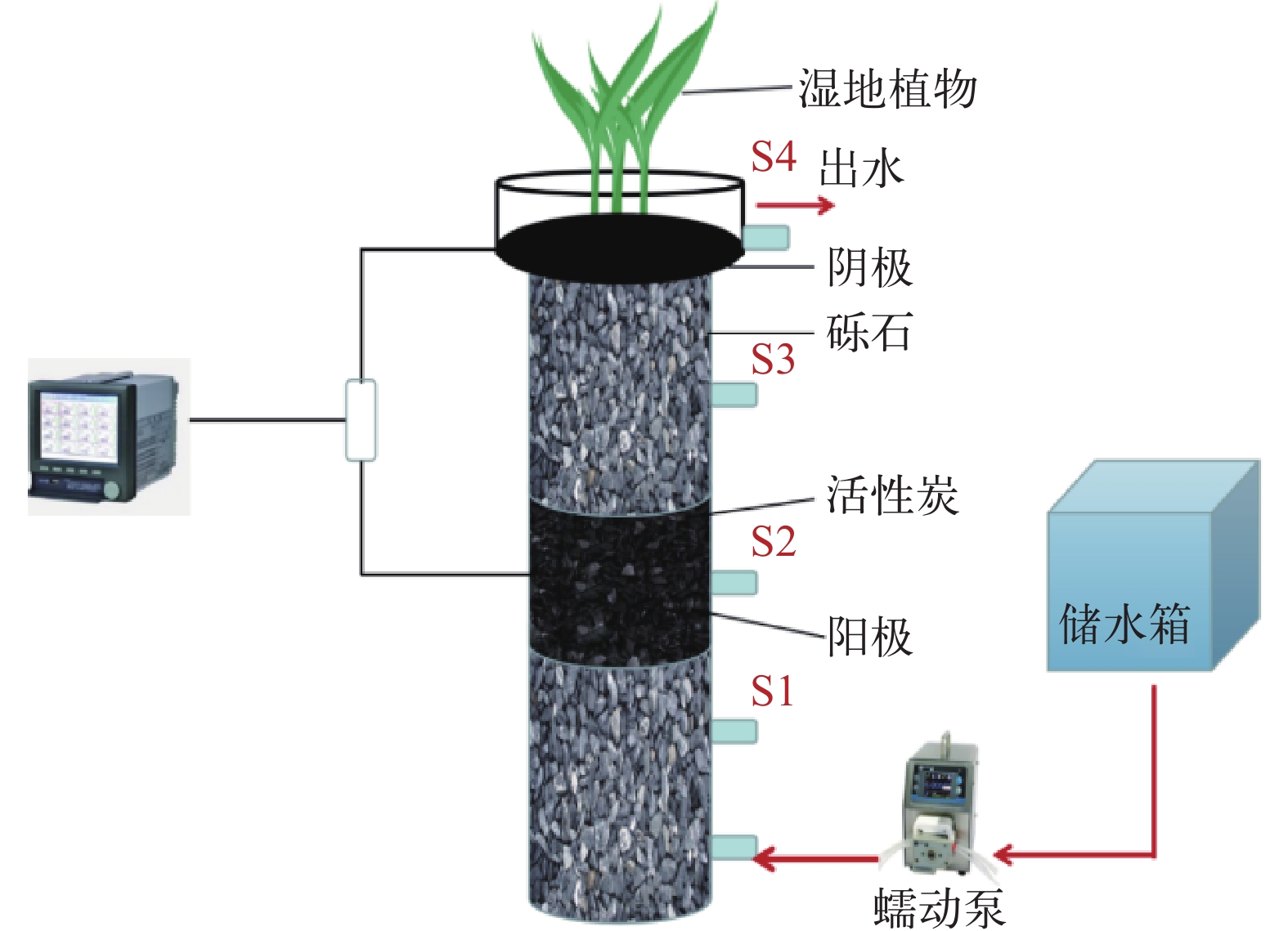
 下载:
下载:
